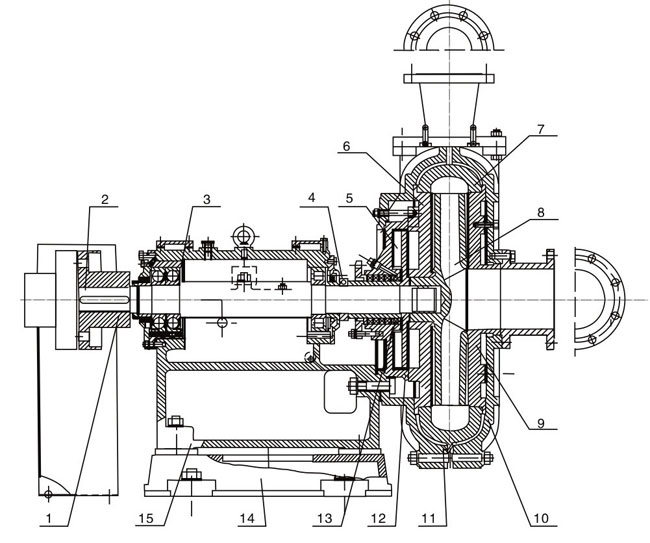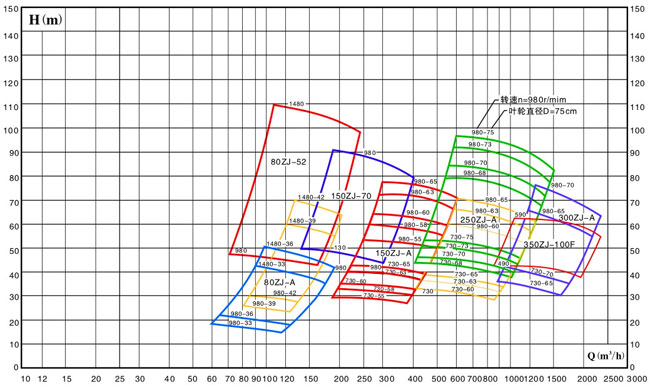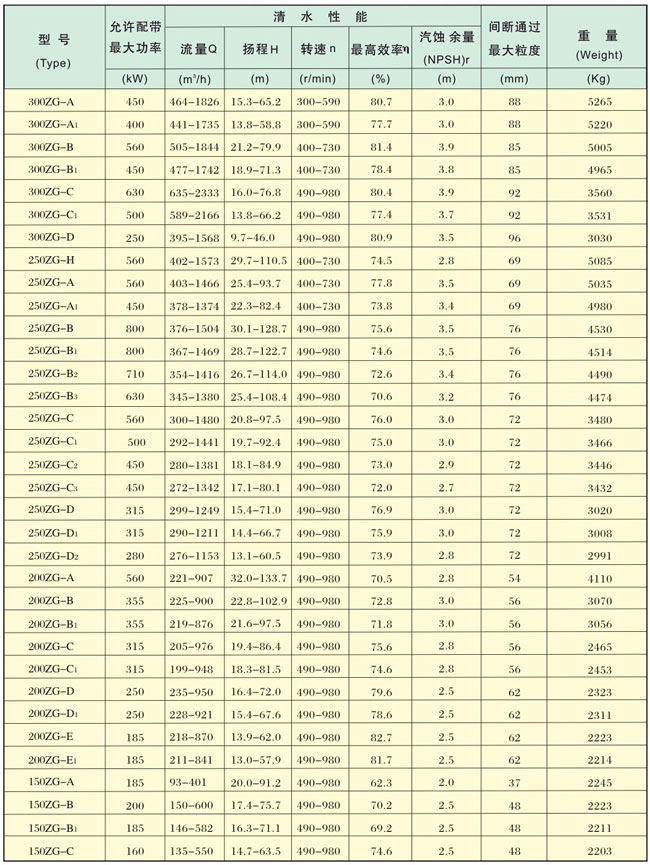1. Determination of the specific gravity, concentration and pH of the slurry
(1) Determination of the specific gravity of the slurry
Determination method: take a certain volume (usually one liter) of the container, after weighing the slurry, weigh it. When the weight of the container is known, the specific gravity of the slurry can be obtained by the following formula.
Where γ - the specific gravity of the pulp;
P 1 - container weight, gram;
P 2 - container and water weight, gram;
P 3 - container and slurry weight, grams.
However, if the dry weight specific gravity and the slurry concentration are known, the specific gravity of the slurry is obtained by the following formula.
Where Q - dry ore, t / h or kg / s;
W——water volume, m 3 / hour or liter (the weight of 3 water per meter is calculated in one ton);
C——concentration of pulp, decimal;
δ - dry weight proportion.
In production practice, the proportion of slurry is often calculated using formula (2). Table 1 for the conversion of slurry specific gravity and slurry concentration.
Conversion table of slurry specific gravity and slurry concentration Table 1
 Â
Ore specific gravity | 2.7 | 3.0 | 3.2 | 3.4 | 3.6 | 3.8 | 4.0 | 4.2 | 4.4 | 4.6 | 4.8 | 5.0 |
Pulp concentration% | Solid: liquid | Slurry specific gravity, kg / liter |
5 10 12 14 16 18 20 twenty two twenty four 26 28 30 32 34 36 38 40 42 44 46 48 50 52 54 56 58 60 62 64 66 68 70 72 74 76 78 80 82 84 86 | 0.053 0.111 0.136 0.163 0.191 0.220 0.250 0.282 0.316 0.351 0.389 0.429 0.471 0.515 0.563 0.613 0.667 0.724 0.786 0.852 0.923 1.000 1.083 1.174 1.273 1.381 1.500 1.632 1.778 1.941 2.125 2.333 2.571 2.846 3.167 3.545 4.000 4.556 5.250 6.143 | 1.033 1.067 1.082 1.097 1.112 1.128 1.144 1.161 1.178 1.195 1.214 1.233 1.253 1.273 1.293 1.314 1.337 1.360 1.383 1.408 1.433 1.459 1.487 1.515 1.545 1575 1.607 1.640 1.675 1.711 1.749 1.788 1.829 1.872 1.918 1.965 2.015 2.067 2.122 2.181 | 1.035 1.071 1.087 1.103 1.119 1.136 1.154 1.172 1.190 1.210 1.230 1.250 1.271 1.292 1.316 1.340 1.364 1.389 1.415 1.442 1.471 1.500 1.531 1.562 1.596 1.630 1.667 1.705 1.743 1.785 1.829 1.875 1.923 1.972 2.027 2.083 2.143 2.206 2.272 2.344 | 1.036 1.074 1.090 1.107 1.124 1.141 1.159 1.178 1.198 1.218 1.238 1.260 1.282 1.305 1.329 1.354 1.377 1.406 1.436 1.463 1.493 1.524 1.556 1.590 1.626 1.663 1.702 1.743 1.786 1.831 1.878 1.927 1.980 2.036 2.094 2.156 2.222 2.292 2.367 2.446 | 1.037 1.076 1.093 1.110 1.127 1.146 1.164 1.184 1.204 1.224 1.246 1.269 1.292 1.315 1.341 1.367 1.393 1.421 1.451 1.481 1.512 1.545 1.580 1.616 1.654 1.695 1.735 1.778 1.823 1.872 1.923 1.971 2.033 2.094 2.157 2.225 2.298 2.374 2.457 2.545 | 1.038 1.078 1.094 1.113 1.130 1.149 1.168 1.189 1.210 1.231 1.253 1.276 1.300 1.324 1.351 1.378 1.405 1.435 1.465 1.498 1.529 1.564 1.603 1.639 1.680 1.721 1.765 1.811 1.859 1.911 1.966 2.023 2.083 2.148 2.214 2.290 2.368 2.452 2542 2.639 | 1.038 1.080 1.097 1.115 1.134 1.153 1.174 1.194 1.215 1.237 1.260 1.284 1.309 1.334 1.361 1.389 1.418 1.448 1.480 1.513 1.547 1.583 1.621 1.661 1.702 1.746 1.793 1.842 1.892 1.947 2.004 2.065 2.130 2.199 2.273 2.351 2.436 2.527 2.624 2.730 | 1.039 1.081 1.099 1.117 1.136 1.156 1.176 1.198 1.220 1.242 1.266 1.290 1.316 1.342 1.370 1.399 1.429 1.460 1.493 1.527 1.563 1.600 1.639 1.681 1.724 1.770 1.818 1.869 1.923 1.980 2.041 2.105 2.174 2.247 2.362 2.410 2.500 2.597 2.703 2.817 | 1.039 1.082 1.100 1.119 1.139 1.159 1.180 1.201 1.224 1.247 1.271 1.296 1.322 1.350 1.378 1.408 1.438 1.471 1.504 1.540 1.577 1.615 1.656 1.700 1.744 1.791 1.842 1.895 1.953 2.012 2.075 2.143 2.215 2.293 2.381 2.465 2.561 2.665 2.778 2.900 | 1.040 1.084 1.101 1.121 1.141 1.161 1.183 1.204 1.228 1.251 1.276 1.302 1.328 1.356 1.385 1.416 1.447 1.480 1.515 1.551 1.589 1.629 1.672 1.716 1.763 1.812 1.864 1.920 1.978 2.041 2.107 2.178 2.254 2.335 2.423 2.517 2.619 2.730 2.850 2.981 | 1.041 1.085 1.103 1.123 1.143 1.164 1.186 1.208 1.231 1.255 1.281 1.307 1.334 1.362 1.392 1.423 1.456 1.490 1.525 1.562 1.602S 1.643 1.686 1.732 1.780 1.831 1.885 1.943 2.004 2.068 2.138 2.212 2.291 2.376 2.468 2.567 2.674 2.791 2.919 3.069 | 1.041 1.086 1.105 1.125 1.145 1.165 1.188 1.212 1.234 1.259 1.285 1.312 1.339 1.368 1.399 1.430 1.463 1.498 1.534 1.573 1.613 1.755 1.700 1.747 1.796 1.849 1.905 1.964 2.027 2.094 2.166 2.243 2.326 2.414 2.511 2.614 2.727 2.850 2.981 3.133 | 1.042 1.087 1.106 1.126 1.147 1.168 1.191 1.214 1.238 1.263 1.289 1.316 1.344 1.373 1.405 1.437 1.471 1.506 1.543 1.582 1.623 1.667 1.712 1.761 1.812 1.866 1.923 1.984 2.049 2.119 2.193 2.273 2.359 2.451 2.551 2.660 2.778 2.907 3.049 3.205 |
(2) Determination of pulp concentration
1. Drying method, take a representative pulp to weigh, then dry the pulp again and weigh it, and calculate the slurry concentration by the following formula.
Where C - pulp concentration, %;
P A - the pulp is heavy, gram;
P B - dry ore, gram.
It takes a certain time to determine the concentration of the slurry by this method to obtain the result, which is inconvenient to use.
2, the concentration pot method, in the production practice, usually with a volume of 1 liter of pot, after weighing the slurry, weighing, in the known concentration of pot weight and the proportion of dry ore, by checking the slurry specific gravity and slurry concentration conversion table 4-10, the pulp concentration can be obtained.
3. The slurry concentration indicator scale has been used to control the slurry concentration in production practice.
(1) Structure and principle, the structure of the slurry concentration indicator scale is shown in Figure 1.

Working principle: The slurry enters the quantitative barrel 2 from the feeding pipe 1 and enters the constant liquid surface measuring barrel 17, and the remaining slurry of the quantitative barrel flows out from the overflow pipe 3 to meet the requirement of quantitative feeding. The slurry discharged from the quantitative barrel discharge pipe 4 is divided into two equal ore flows into the barrel through the guide chamber in the measuring barrel, one part is excluded from the discharge pipe 18 of the measuring barrel, and the other part is overflowed by the measuring barrel. Tube 15 is excluded. In this way, the concentration of the ore slurry in the measuring barrel can be made uniform and the liquid level is stable. When the concentration changes, the buoyancy of the concentration buoy 16 changes, and the buoy rises and falls accordingly. The pointer 9 of the suspended buoy indicates the reading of the slurry concentration as the action moves.
(2) Pay attention to the following problems when using
1) The scale pointer needs to be straight, the material is light, and the support tool holder should be made of wear-resistant material.
2) Regularly use manual measurements to calibrate the slurry concentration readings. As indicated with the measured readings do not match, performing the fine tuning by adjusting the nut 13 and the counterweight 10, 14 or by changing the concentration of the float sink iron chain, until it meets the requirement Found reading. [next]
(III) Determination of pH value of pulp
1. Determine the pH of the slurry using a pH test paper (or litmus paper). During the measurement, the 1/2~1/3 part of the pH test strip is directly inserted into the pulp. After 2~3 seconds, the test paper is taken out, and the degree of discoloration of the pH test paper in contact with the pulp is compared with the standard color. The pH value of the pulp is measured. This method is simple and can roughly measure the pH value of the slurry.
2. Determine the pH value of the slurry with a pH meter (or pH meter). The measurement should be carried out according to the specifications of the acidity meter used. The working principle of different types of acidity meter of the above-mentioned seafood is that the pH value is measured by the potential method. It is mainly to use a pair of electrodes to generate different electromotive forces in different pH solutions to calculate the newly generated electromotive force according to the Nistel formula.
Where ΔMV - produces the difference in electromotive force millivolts;
ΔpH - the difference between different pH solutions;
t - the temperature of the solution being measured, °C.
At this time, one electrode is a glass electrode indicating electrode, and the other is a calomel electrode reference electrode. Some acidity meters use a composite electrode to measure the pH. In the composite electrode, the glass electrode of the inner layer is the indicator electrode, and the silver chloride electrode of the outer layer is the reference electrode. In the process of determining the pH value, the indicator electrode changes with the pH value of the solution to be tested, and should satisfy the Nistel formula, and the reference electrode is independent of the solution to be tested, and only acts as a salt bridge.
3. Preparation of standard solution. The standard solution is usually supplied with the acidity meter at the factory. It is divided into three types: acid, neutral and sputum. Choose to use according to the specific conditions of the predicted slurry. For example, when the pulp is acidic, the acidic standard solution is selected during the measurement, and when it is inert, the alkaline standard solution is used for the determination.
Standard solution preparation method:
(1) The acidic standard solution is saturated potassium hydrogen tartrate. The potassium hydrogen tartrate is placed in distilled water, heated at 40 ° C for all dissolution, and then cooled to about 25 ° C. Crystals are precipitated to reach saturation. This saturated solution can be used as an acidic standard solution.
(2) neutral standard solution using an acid or potassium dihydrogen phosphate, disodium hydrogen phosphate 0.025M 0.025M of can.
(3) the standard alkaline solution using 0.01M borax.
pH standard solution Table 2
Solution | Temperature °C |
0 | 10 | 20 | 25 | 30 | 38 | 40 | 50 | 60 |
Saturated potassium hydrogen tartrate | - | - | - | 3.56 | 3.55 | 3.54 | 3.54 | 3.55 | 3.57 |
0.025M potassium dihydrogen phosphate | 6.98 | 6.92 | 6.88 | 6.86 | 6.85 | 6.84 | 6.84 | 6.83 | 6.84 |
0.025M disodium hydrogen phosphate |
0.01M Borax | 9.46 | 9.33 | 9.22 | 9.18 | 9.14 | 9.07 | 9.07 | 9.01 | 8.96 |
Note: M is the equivalent concentration
From the above table, the characteristics of the standard solution are as follows: one is easy to prepare, and the other is stable physicochemical properties.
4, the use of acidity timing should pay attention to matters
(1) The user should first familiarize with the instrument usage and operating procedures.
(2) The design of the acidity meter can only indicate the difference between the liquid to be tested and the standard solution. Therefore, the pH of the standard solution is very accurate and reliable.
(3) The acidity meter should be corrected as much as possible with a standard solution similar to the liquid phase to be tested.
(4) After the acidity meter is calibrated with the standard solution, it should be calibrated with another standard solution.
(5) Before using the acidity meter, the glass electrode and bulb should be soaked in distilled water for 4-6 hours or longer before use. It is best to immerse it in water after use.
(6) The bulb of the glass electrode is easy to break and must be used with great care.
(7) The glass electrode should be used in a strong (or strongly acidic) solution, and should be washed as soon as possible after use. [next]
Second, the determination of the concentration and dosage of the drug
(1) Determination of the concentration of the drug
1. The concentration of a drug that is easily soluble in water (such as Sudar ash) is determined by indirect measurement of the concentration of the drug using the method of measuring the specific gravity of the drug solution (the determined concentration of the drug is a fixed value). Take 200~350 ml of the prepared reagent solution and put it in a container (usually a 250-500 ml beaker). Gently put the Baume hydrometer into the container to float it in the liquid. Wait for it. After stabilization, the scale of the buoy at the junction of the liquid level is observed as the specific gravity of the solution. The measured specific gravity of the liquid medicine is checked against the determined specific gravity of the liquid, and the concentration of the drug is changed.
2. For the determination of fatty acid agents (such as Tal oil) which are difficult to dissolve in water, the chemical solution is sampled for chemical analysis to see the content of fatty acids (because the determined concentration of the drug is a fixed amount of fatty acid) Value), the concentration of the agent can be known indirectly. After analysis, if the content of fatty acids in the medicament is greater than the fatty acid content at the determined concentration of the medicament, it indicates that the concentration of the medicament is too high, and it needs to be diluted with water. On the contrary, the concentration of the medicament is low, and the dosage of the medicament needs to be increased.
(2) Determination of the dosage of the drug
The liquid medicine is mostly a bucket type drug delivery machine or a siphon tube type, and the measuring cylinder intercepts the liquid medicine for a certain period of time at the administration point, calculates the volume of the medicine solution per minute, and then calculates the dosage of the medicine by the following formula:
Where g is the amount of dosing per ton of mine, g/t;
P——agent concentration, %;
Δ——specific gravity of the liquid;
A——the volume of the liquid should be added, ml/min;
Q 0 - treatment of minerals, tons / hour.
If the measured dosage of the liquid does not match the required amount, it should be adjusted as needed.
Naipu WS Dredging Pump is single-stage single-suction cantilever horizontal Centrifugal Pump with advantages of light weight ,good wear-resistant ,super dredging performance ,perfectly suited for the dredge on the whole construction ,high multiple economy benefits and so on .It throughout meets requirements of the dredge to dredging pumps .The pump mainly consists of the pump head , gearbox specifically for the dredging pump ,high elastic coupling and supervisor system of the driving device for the dredge.
Typical Applications---
Suction Hopper Dredging
Constructional Material
Sand gravel processing
Barge Loading
Sand Reclamation
WS Dredging Pump Construction Drawing

Main Part Number At The Drawing
|
1 – Shaft
2 – Frame
3 – Mechanical Seal Assembly
4 – Connecting Plate
5 – Rear Liner
|
6 – Pump Casing
7 – Cover Plate
8 – Front Liner
9 – Impeller
10– Support
|
Materials of Construction
|
|
VOLUTE
|
IMPELLERS
|
BASE
|
EXPELLER
|
EXPELLER RING
|
SHAFT SLEEVE
|
SEALS
|
|
Standard
|
High Chrome Alloy
|
High Chrome Alloy
|
Cast Iron
|
Chrome Alloy
or
SG Iron
|
Chrome Alloy
or
SG Iron
|
SG Iron
|
Natural Rubber
|
|
Options
|
SG Iron
|
SG Iron
|
Mild Steel
Fabricated
|
SG Iron
|
SG Iron
|
EN56C
Ferralium
Hasteloy C
Ceramic
Stellite
Chrome Oxide
|
Nordel
Neoprene
Viton
Butyl
EPDM
|
WS Dredging Pump Selection Chart

WS Dredging Pump Performance Parameters

WS Dredging Gravel Pump
Dredging Slurry Pump, River Sand Dredging Pump, Submersible Dredging Pump, Horizontal Dredging Pump
Shijiazhuang Naipu Pump Co., Ltd. , https://www.naipu-pump.com








